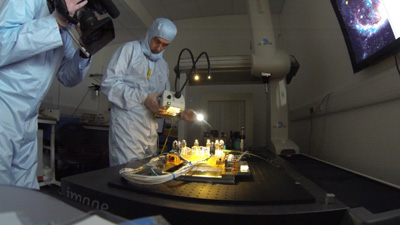Heart of space mission cleared for launch by University of Glasgow
Published: 3 June 2013
Scientists at the Institute for Gravitational Research have successfully concluded extensive testing of a vital component of a future space mission.
Scientists at the University of Glasgow’s Institute for Gravitational Research (IGR) have successfully concluded extensive testing of a vital component of a future space mission.
The optical bench of the LISA Pathfinder (LPF) mission is the super-sensitive heart of a technology demonstrator mission which will pave the way for a future detector to measure gravitational waves. These ripples in spacetime are caused by massively violent astronomical events such as the collision of black holes and the explosion of dying stars.

The IGR team in the School of Physics and Astronomy demonstrated that the high-precision sensor system is ready to survive tremendous forces of up to 35 times the gravitational acceleration on Earth during rocket launch.
Dr Christian Killow, Scottish Universities Physics Alliance Advanced Fellow at the University, said: “With these successful tests we have reached an important milestone. The sophisticated laser interferometer performs superbly and is ready for its job in space. We are really excited that the LISA Pathfinder mission is now well positioned for launch in 2015.”
LISA Pathfinder is a European Space Agency (ESA) technology test mission that aims to prove essential key technologies for future space-based gravitational-wave observatories, which cannot be tested on Earth, but only in space.
For this purpose, one laser arm of a planned large gravitational wave mission is reduced from millions of kilometres to 40cm to fit into a single spacecraft. The optical bench tested at the IGR in Glasgow is the heart of LPF.
It has now been delivered to Astrium Germany for further integration into the LISA Pathfinder Technology Package. At Astrium members of the Glasgow team performed health checks on the optical bench photodiodes that turn the laser beams into electrical signals, and also micron-level measurement of the beam positions on the photodiodes – a very strong indicator that the bench survived transit unchanged.
LISA Pathfinder is paving the way for a large-scale space mission designed to detect one of the most elusive phenomena in astronomy – gravitational waves. Extreme precision is required to detect the tiny ripples in the fabric of space and time predicted by Albert Einstein. A direct detection of gravitational waves will add a new sense to our perception of the Universe: for the first time researchers will be able to listen to the Universe: gravitational waves are in some respects similar to sound waves. Hence gravitational wave astronomy will complement understanding of the Universe and its evolution.
Gravitational waves measured by a large mission in space will allow scientists to trace the formation, growth, and merger history of massive black holes. It will also enable scientists to confront General Relativity with observations, and will probe new physics and cosmology.
LPF is an ESA led mission. It involves European space companies and research institutes from France, Germany, Italy, The Netherlands, Spain, Switzerland and UK and the US space agency NASA.
The concept and details of the optical sensing scheme for LISA Pathfinder have been developed at the University of Glasgow based on the initial work at the Max Planck Institute for Gravitational Physics (Albert Einstein Institute) in Hanover, Germany. Its director Karsten Danzmann is Co-Principal Investigator of the mission and shares the scientific leadership with Stefano Vitale, University of Trento, Italy.
In order to build the optical bench the IGR scientists, led by Dr. Harry Ward, developed the silicate bonding technique to allow robust, sub-micron optical component positioning – an enabling technology that is now finding additional uses in ground and space based activities, and in both academic and industrial endeavours.
The research and development at the IGR has been funded by the UK Science and Technologies Facilities Council (STFC), by the UK Space Agency, by ESA, the Scottish Universities Physics Alliance and by the University of Glasgow.
Find out more
ENDS
For more information contact Ross Barker in the University of Glasgow Media Relations Office on 0141 330 3535 or email ross.barker@glasgow.ac.uk
First published: 3 June 2013
<< June

